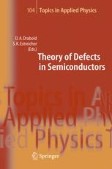Search
Search Results
-
Ultrafast Scanning Tunneling Microscopy: Principles and Applications
The growing field of nanotechnology requires special tools capable of probing ultrafast surface dynamics on atomic scales in order to unveil...
-
Terahertz Radiation from Semiconductors
We provide a review of the different schemes for generating terahertz (THz) radiation using photoconductive emitters excited by femtosecond...
-
Spontaneous Emission from Semiconductors After Ultrafast Pulse Excitation: Theory and Simulation
In this chapter, we review the recent progress in the theoretical description of ultrafast phenomena in the spontaneous emission of pulse-excited...
-
Empirical Molecular Dynamics: Possibilities, Requirements, and Limitations
Classical molecular dynamics enables atomistic structure simulations of nanoscopic systems to be made. The method is extremely powerful in solving...
-
Defect Theory: An Armchair History
This introductory chapter begins with a summary of the developments of the theory of defects in semiconductors in the past 50 years. This is followed...
-
Quasiparticle Calculations for Point Defects at Semiconductor Surfaces
We present a quantitative parameter-free method for calculating defect states and charge-transition levels of point defects in semiconductors. It...
-
Light Induced Effects in Amorphous and Glassy Solids
In this Chapter, we discuss how exposure to light can affect the properties of disordered materials and review our recent computational studies of...
-
Defects in Amorphous Semiconductors: Amorphous Silicon
Defects in disordered (amorphous) semiconductors are discussed, with an emphasis on hydrogenated amorphous silicon. The general differences between...
-
Dynamical Matrices and Free Energies
The calculation of the entire dynamical matrix of a periodic supercell (containing a defect or not) provides several most useful pieces of...
-
Multiscale Modeling of Defectsin Semiconductors:A Novel Molecular-Dynamics Scheme
Now that the modeling of simple semiconductor systems has become reliable, accurate and routine, attention is focusing on larger scale, more complex...
-
Supercell Methods for Defect Calculations
Periodic boundary conditions enable fast density-functional-based calculations for defects and their complexes in semiconductors. Such calculations...
-
The Calculation of Free-Energiesin Semiconductors: Defects, Transitionsand Phase Diagrams
In this chapter we review a series of novel techniques that make possible the efficient calculation of free energies in condensed-matter systems,...
-
Marker-Method Calculations for Electrical Levels Using Gaussian-Orbital Basis Sets
The introduction of defect-related states in the bandgap of semiconductors can be both advantageous and deleterious to conduction, and it is...
-
Carrier Dynamics in III--Nitrides Studied by Time-Resolved Photoluminescence
Recent results on time-resolved photoluminescence (PL) studies for Al-rich AlGaN alloys, InAlGaN quaternary alloys, InGaN/InAlGaN and GaN/AlN...
-
Ultrafast Coherent Dynamics in Semiconductor Quantum Dots
In this chapter we will review the studies on ultrafast coherence phenomena of self-assembled semiconductor quantum dots (SAQDs). These...
-
Generation of Coherent Acoustic Phonons in Nitride-Based Semiconductor Nanostructures
In this chapter, we review experimental and theoretical aspects of coherent acoustic phonon generation in nitride-based semiconductor...
-
Quantum Monte Carlo Techniques and Defects in Semiconductors
The continuum variational and diffusion quantum Monte Carlo (VMC and DMC) techniques are stochastic methods for obtaining expectation values of...
-
Foreword
Man sollte sich mit Halbleitern nicht beschäftigen, das sind Dreckeffekte – wer weiss, ob sie wirklich existieren. Wolfgang Pauli, 1931
-
Femtosecond X-Rays and Structural Dynamics in Condensed Matter
In this chapter, some of the recent advancements in the nascent field of femtosecond X-ray scattering are reviewed. First, we discuss selected...
-
Optical Studies of Electric-Field-Induced Electron and Hole Transient Transports and Optical Phonon Instability in Semiconductor Nanostructures
In this chapter the use of picosecond/subpicosecond time-resolved/transient Raman spectroscopy to study electric-field-induced transient...
